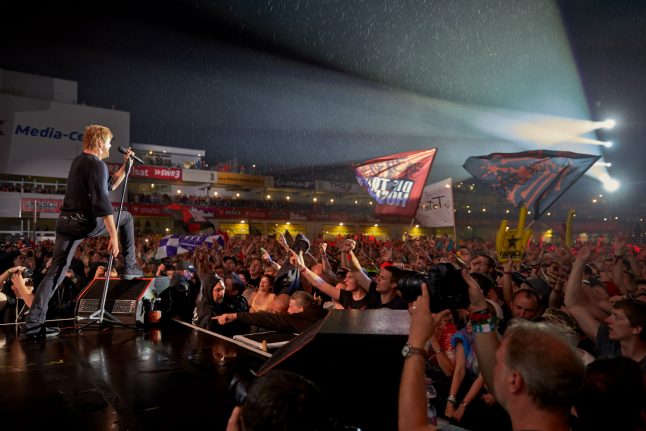Major Tom (Völlig Losgelöst) by Peter Schilling
‘Major Tom’ by Peter Schilling, released in 1982, is an example of Neue Deutsche Welle and Space Rock. The song, which unofficially carries on the legacy of the fictional astronaut from David Bowie’s 1969 hit of the same name, reached number one in West Germany, Austria and Switzerland. Following this success, an English Version, ‘Major Tom (Coming Home)’ was released in 1983.
Fremd im Eigenen Land by Advanced Chemistry
Translated as “Stranger in my own country”, this protest song from Heidelberg hip hop crew, Advanced Chemistry, paved the way for German hip hop in the 90’s. It was released in 1992 in reaction to the racist pogroms of Rostock-Lichtenhagen and combines radical political views with emotional reactions to personal experiences.
Subzero by Ben Klock
The track ‘Subzero’, released in 2012, is a classic example of electronic dance music. Its creator, Ben Klock, is one of the resident DJs at Berghain, Berlin’s most notorious techno club. Germany is known throughout the world for its techno scene which has played a huge role in party culture since the genre first emerged in the 1980’s.
Halt dich an diener Liebe fest by Ton Steine Scherben
Ton Steine Scherben are a German rock band, well known in the 70’s and early 80’s for their socially critical lyrics. The song ‘Halt dich an deiner Lieber fest’, meaning ‘hold on tight to your love’, was released in 1975 and is one of the band’s best known tracks.
Über den Wolken by Reinhard Mey
Reinhard Mey is a prolific singer-songwriter who many Germans will remember from their youth. Born during the Second World War, he has released almost 400 songs in his lifetime, but the best-loved is the nostalgic and hopeful song, ‘Über den Wolken’, or ‘above the clouds’.
Pure Vernunft darf niemals siegen by Tocotronic
The song ‘Pure Vernunft darf niemals siegen’, which translates to ‘pure reason must never prevail’, is a prime example of the German ‘discursive rock’ movement. The song’s creators, Tocotronic, are an indie-pop/rock band from the late 20th century music movement known as the ‘Hamburger Schule’. The movement was considered “discursive” as it combined guitar heavy music with left-wing, “intellectual” lyrics and built on the traditions of the Neue Deutsche Welle, incorporating pop, punk, indie rock and grunge.
Bist du Down? by Ace Tee
Hamburg-based rapper Ace Tee, although fairly new to the music scene, was dubbed on Twitter the “new TLC” and has earned her place on this list due to her creation of possibly the most silky smooth sounding German R&B you will ever hear. Ace Tee is an example of the modern, digital revolution in the music scene, rising to international fame after achieving viral sucess with the song ‘Bist Du Down’.
Kaltes klares Wasser by Malaria!
Cult electronic band, Malaria! were produced by Mark Reeder, composer and score producer of the film ‘The B-Movie: Lust & Sound’. ‘The B-Movie is a documentary film, released in 2015, about ‘music, art and chaos’ in the pop- and subculture melting pot that was West Berlin the 80’s, of which Malaria! were a part. The avante garde duo found fame in Germany and around the world, particularly with the song ‘Kaltes Klares Wasser’.
Eva Braun by Die Ärtze
Punk band Die Ärtze also featured in the 80’s Berlin documentary ‘B-Movie’ and are one of the most successful German punk-rock groups of all time. The song ‘Eva Braun’ is a satirical ode from the left-wing band to Hilter’s mistress and, due to its taboo subject matter and concerns about its meaning being misinterpreted, was never officially released.
Autobahn by Kraftwerk
‘Autobahn’ by Kraftwerk is iconic due to its amalgamation of techno and Autobahns, two things for which Germany is world famous. Pioneering electro-pop group Kraftwerk, meaning “power plant”, live up to their name with their machine like musical style. They have been hugely influential on the electronic music scene since the 1970’s and were dubbed by the New York Times as “the Beatles of electronic dance music” in 1997.
Ich rolle mit meim Besten by Haftbefehl ft. Marteria
Die Toten Hosen are one of the most successful German bands in history. Their style is mostly rock with elements of punk, and they have reached number one in the German album charts over 10 times. The song ‘Tage Wie Diese’ is about the collective feeling of joy from being at a concert. It was released in 2012 and was named ‘Hit of the Year 2012’.
99 Luftballons by Nena



 Please whitelist us to continue reading.
Please whitelist us to continue reading.